A Road Trip from Agra to the Historic Blue City of Jodhpur in Rajasthan
 |
| Entrance of Mehrangarh Fort, Jodhpur (composite) |
After checking out the Taj Mahal in dense smog, we drive off from Agra for a 600 km 12-hour drive to explore Jodhpur, Rajasthan which is often referred to as the "Sun City" or the "Blue City".
The first part of the drive is on NH-21 Bikaner-Agra highway to Jaipur. We stop halfway between Agra and Jaipur at the aptly named Rajputana Midway for lunch. This upscale restaurant sees a lot of foreigners resulting in expensive but meh food. You will do far better at authentic roadside dhabas unless you are among the target customers of this restaurant.
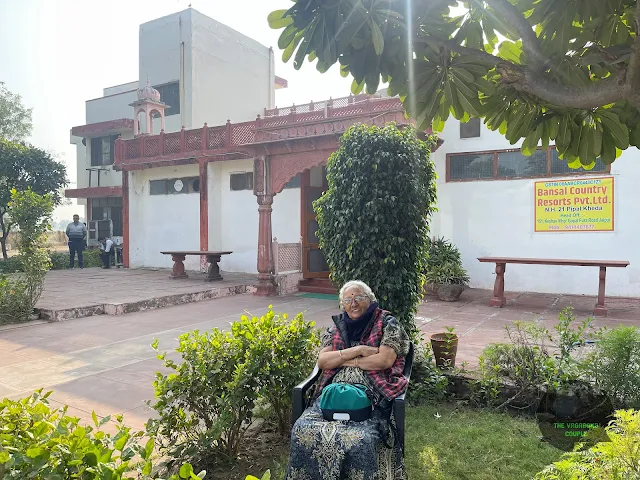 |
| Rajputana Midway restaurant, NH21, Rajasthan |
Bypassing downtown Jaipur on its Ring Road, we continue west on NH-48 Japipur-Ajmer Expressway. NH-48 is India's longest National Highway, a major artery stretching a whopping 2,807 kilometers (1,744 miles) from the bustling capital of Delhi in the north to the vibrant city of Chennai in the south. It snakes through seven states: Delhi, Haryana, Rajasthan, Gujarat, Maharashtra, Karnataka and Tamil Nadu, connecting countless towns and cities along the way. We catch the sunset from NH-48 driving past Hanuman Hotel and Dhaba at the town of Dantri.
 |
| Sunset on National Highway 48 approaching Dantri |
As night falls, we cross Ajmer and Beawar on to NH-25 Jaipur-Jodhpur highway. We stop for dinner at the Midway Megh Malhar Hotel in the town of Khinawari. The general ambience of the restaurant is of unusually refined taste. A friendly labrador welcomes us into immaculate gardens with manicured, carefully selected and rare flora. We chat a bit with the owner who maintains the little paradise within the walls of his hotel and restaurant. He has two other beautiful dogs and is obviously a connoisseur of the fine arts, having named his establishment after a great Hindustani Classical Raga of India.
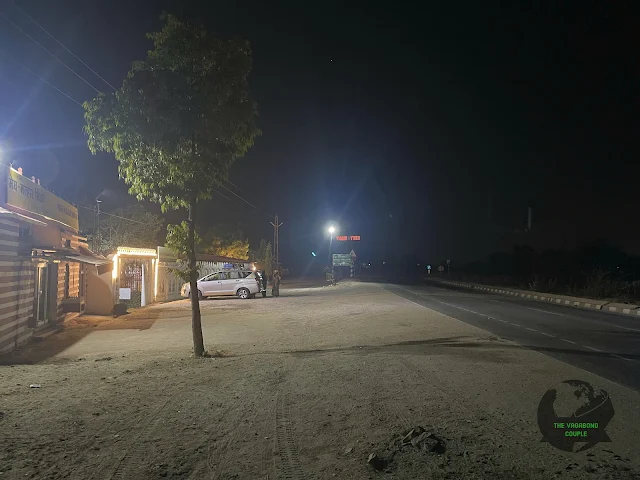 |
| Midway Megh Malhar Hotel, Khinawari on National Highway 25 (Jodhpur-Jaipur Hwy) |
Also at the Megh Malhar, we try the legendary Rajasthani "laal maas" or "handi ka mutton" for the first time. This fiery mutton curry is a famous culinary gem, renowned for its vibrant red color, intense spiciness and complex blend of flavors. Laal Maas is deeply rooted in Rajasthani culture and history. It was traditionally enjoyed by royalty and hunters, often made with wild game meat. Today, it's a staple on Rajasthani menus and a must-try for any food enthusiast.We have it with "bajra ki roti" and it is gorgeous and easily among the most delicious of food I have had anywhere in the world!
 |
| Rajasthani Laal Maas with Bajra ki Roti |
Laal Maas translates to "red meat" in Hindi, aptly describing the dish's signature bright red color. It is a mutton curry traditionally made with bone-in pieces of lamb or goat, cooked in a thick, fiery gravy infused with a generous amount of red Mathania chilies. The base often includes yogurt, ginger, garlic and a combination of aromatic spices like coriander, cumin and turmeric.
Laal Maas is not for the faint of heart. The fiery Mathania chilies add a potent kick that's central to the dish's character. Be prepared for a delicious burn while chili heat takes center stage complemented by a symphony of other flavors. The tanginess of yogurt, the warmth of spices and the earthiness of ginger-garlic create a complex and unforgettable taste profile. Slow cooking ensures the mutton becomes melt-in-your-mouth tender, soaking up the flavorful gravy and spices.
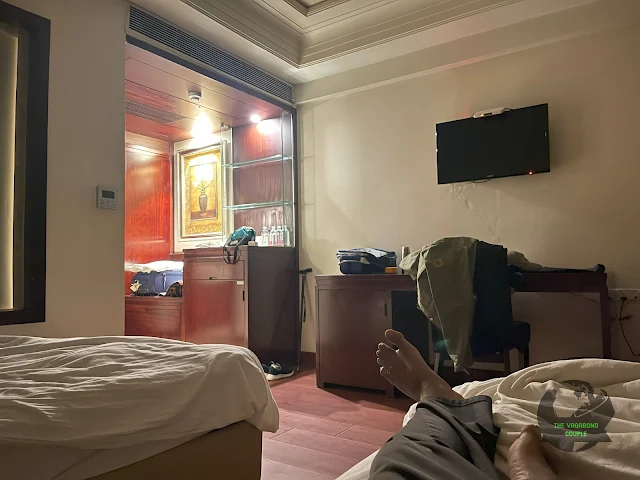 |
| Hotel Park Plaza, Jodhpur |
We start exploring Jodhpur the next morning. Often referred to as the "Blue City" due to distinctive blue-painted houses that adorn its landscape, Jodhpur is steeped in history and culture, its rich heritage attracting tourists from around the world.
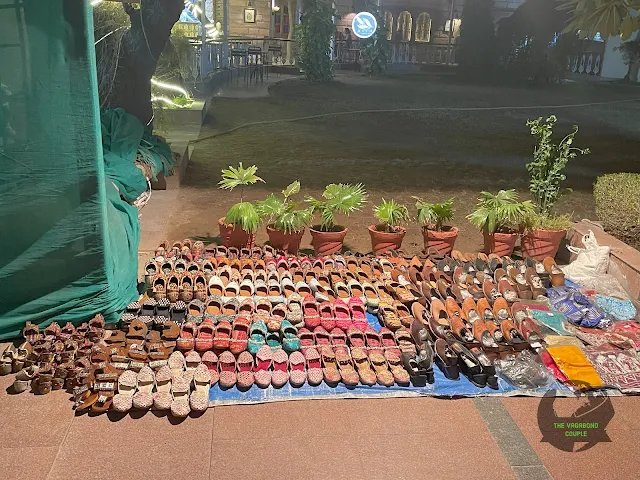 |
| Jodhpuri slippers and dupattas for sale by a vendor beside the hotel's lawn |
Jodhpur was founded in 1459 by Rao Jodha, the chief of the Rathore clan. The city's strategic location on the trade routes between Delhi and Gujarat contributed to its early growth and prosperity.
Jodhpur is the gateway to the Marwar region, which historically encompasses the hot and arid western part of Rajasthan. The Marwar rulers and the Marwari people played a crucial role in shaping the rich cultural and economic landscape of the region.
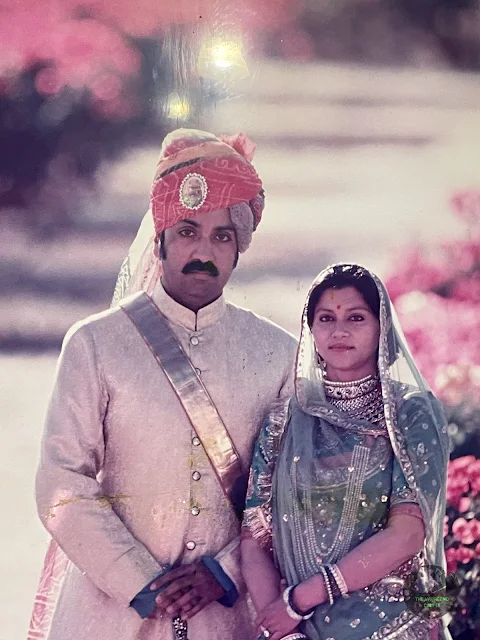 |
| Current Maharaja Gaj Singh II and Maharani Hemalata Rajye of the Kingdom of Jodhpur-Marwar Portrait at Umaid Bhawan Palace, Jodhpur |
Mehrangarh Fort: Jodhpur's Crown Jewel Gleaming Against the Thar Desert
Rising majestically from a 400-foot sandstone hill, Mehrangarh Fort reigns supreme over the "Blue City" of Jodhpur. Its imposing red sandstone ramparts, intricately carved palaces and rich history weave a tapestry of Rajput power and resilience. Mehrangarh, meaning "Fort of the Sun," aptly reflects its status as the ancestral home of the Rathore clan, who trace their lineage back to the Sun God Surya. The impregnable walls, some rising to a height of 120 feet, bear the scars of numerous sieges, whispering tales of Rajput valor.
 |
| Mehrangarh Fort, Jodhpur, Rajasthan |
Construction of Mehrangarh began in 1459 by Rao Jodha, founder of Jodhpur. Over centuries, successive rulers expanded and strengthened the fort, adding seven gates, including the Jai Pol, a victory arch commemorating a triumphant battle.
 |
| The "Jai Pol" Gate, Mehrangarh Fort |
Within the fort's labyrinthine lanes, a treasure trove of Rajput architectural splendor awaits.
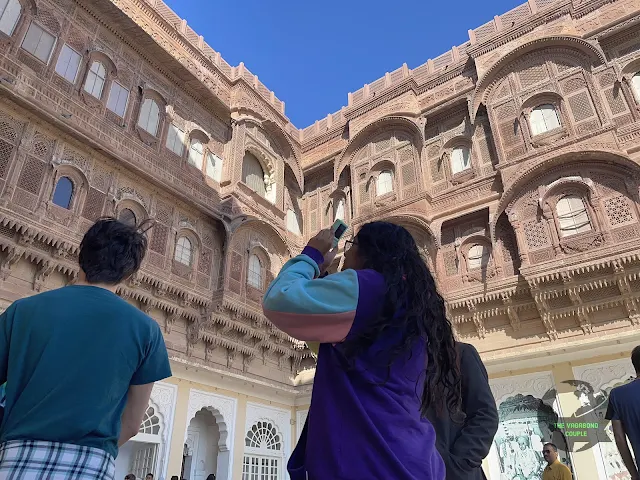 |
| Mehrangarh Fort |
Among the various architectural styles that adorn this regal state, sandstone architecture holds a special place, encapsulating the spirit of Rajasthan's enduring beauty and artistic finesse.
 |
| Mehrangarh Fort |
The craftsmen of Rajasthan have honed their skills over generations, employing traditional techniques to carve intricate patterns and motifs into the sandstone. The delicate jali work, where geometric or floral patterns are intricately carved into stone screens, not only enhances the aesthetic appeal but also serves practical purposes, allowing ventilation while maintaining privacy.
 |
| Mehrangarh Fort |
While the sandstone architecture of Rajasthan has withstood the test of time, efforts are being made to preserve and protect these historical gems. Conservation projects, community initiatives, and strict regulations on construction practices aim to safeguard the unique heritage of the region, ensuring that future generations can continue to marvel at the architectural wonders of Rajasthan.
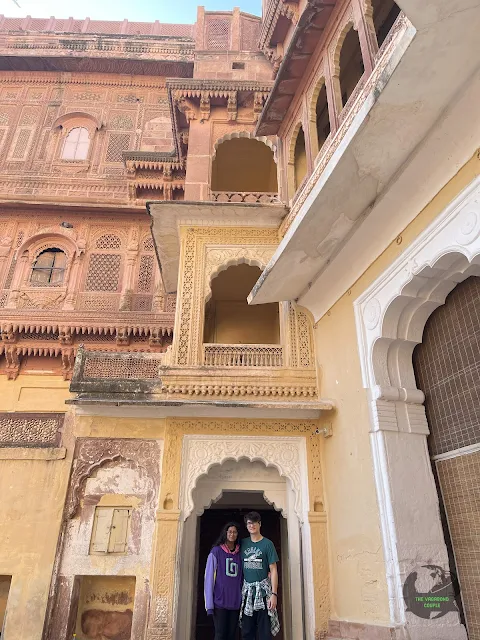 |
| Mehrangarh Fort |
The intricately carved Mehrangarh Museum showcases breathtaking exhibits of royal artifacts, paintings and weapons. Among the displays is a sword belonging to Mughal Emperor Akbar. This exquisite piece is believed to date back to 1560 CE and boasts several fascinating features. The hilt is adorned with intricate gold damascene work, a decorative technique, perfected in Damascus, involving inlaid patterns of gold wire on the blade.
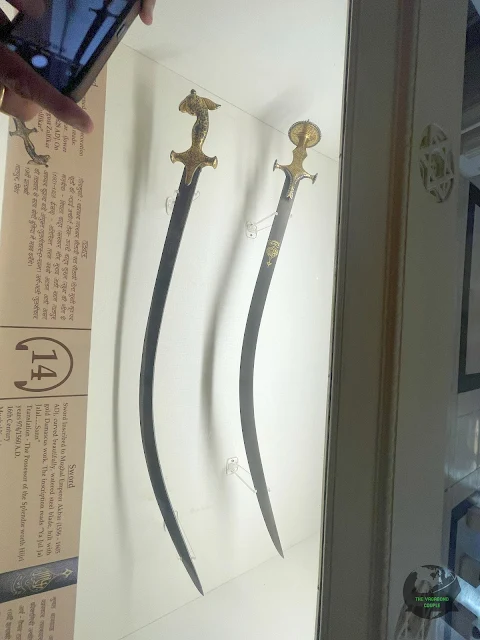 |
| Akbar's Sword |
The blade bears an inscription in Persian that reads "Ya Jul Jalal...Sann," which refers to a powerful phrase along the lines of "The Possessor of the Splendor worth" and Hijri year 974 (1560 CE).
 |
| Akbar's Sword |
While some experts debate the sword's direct connection to Akbar, it undeniably serves as a valuable artifact reflecting Mughal craftsmanship and military prowess during his reign.
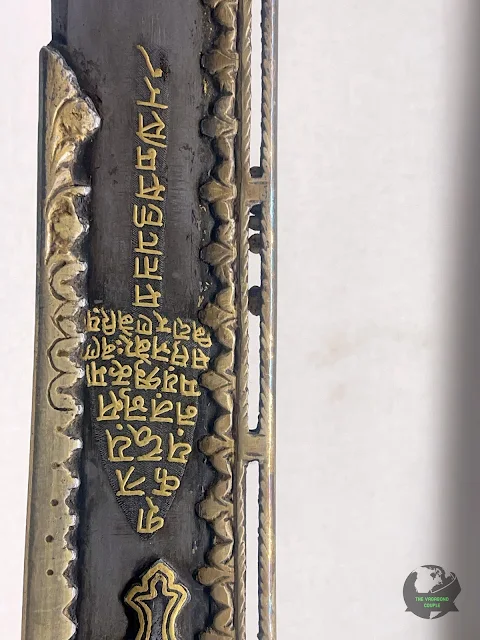 |
| Akbar's Sword |
Moti Mahal, the "Pearl Palace," dazzles with its mirrored walls and delicate inlaid work. It was built during the reign of Maharaja Sur Singh, who ruled Marwar from 1595 to 1619. The construction of the palace reflects the opulence and architectural prowess of the Rathore rulers of Jodhpur.
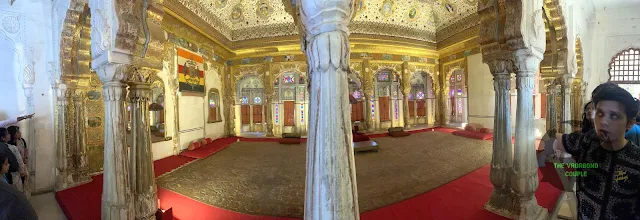 |
| Moti Mahal |
Moti Mahal served as the private residence for the Maharajas of Jodhpur-Marwar. The palace was designed not only for residential purposes but also as a space for conducting official court proceedings and meetings.
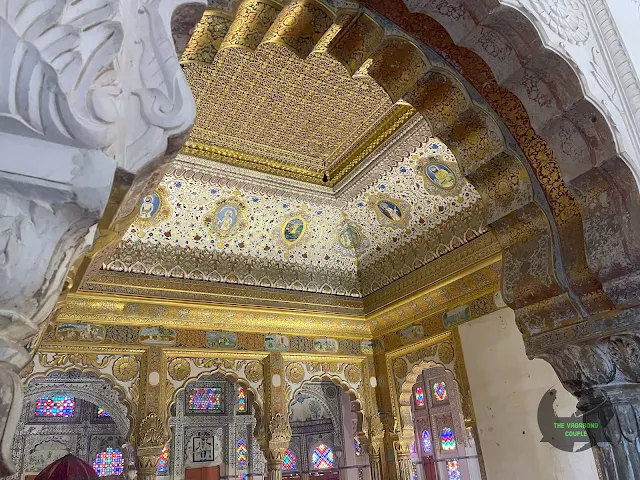 |
| Moti Mahal |
The architecture of Moti Mahal is a blend of Rajput and Mughal styles. The palace is adorned with intricately carved panels, latticed windows and beautiful floral motifs. The use of white marble, which gives the palace its name, adds to its elegance and earned it the title "Pearl Palace."
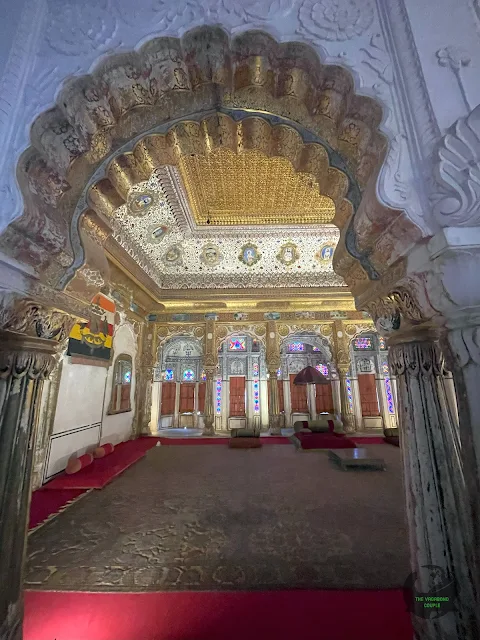 |
| Moti Mahal |
 |
| Phool Mahal |
Climb the ramparts and be awestruck by the panoramic vista of Jodhpur unfolding beneath you. The sprawling blue houses, dotted with temples and palaces, stretch out towards the golden expanse of the Thar Desert. Witness the mesmerizing sunset paint the sky in fiery hues, casting an ethereal glow upon the fort's ancient stones.
 |
| Blue Houses of "Blue City" Jodhpur |
The indigo-hued houses that give Jodhpur its "Blue City" moniker have cultural and historical significance. Traditionally, the Brahmin caste painted their homes blue to distinguish themselves and to denote a sense of spirituality. The color also has practical benefits, such as keeping homes cool in the scorching desert heat.

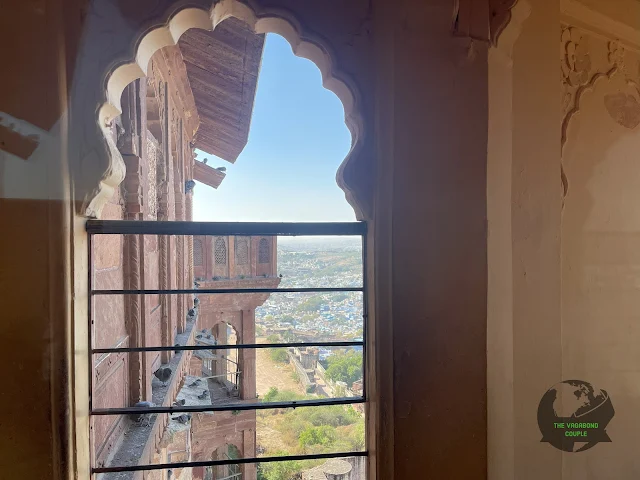 |
| Blue Houses and Temples of Jodhpur as viewed from Mehrangarh Fort |
There is a nursery in the fort where royal babies were taken care of by assistants of queens and royal mothers.
 |
| Royal Baby Bed |
The fort's legacy extends beyond its walls. Every evening, the Mehrangarh Fort reverberates with the sounds of the "Echoes of Mehrangarh" - a spectacular light and sound show that narrates the fort's captivating history. Food lovers can indulge in traditional Rajasthani cuisine at the Gypsy Restaurant within the fort's grounds.
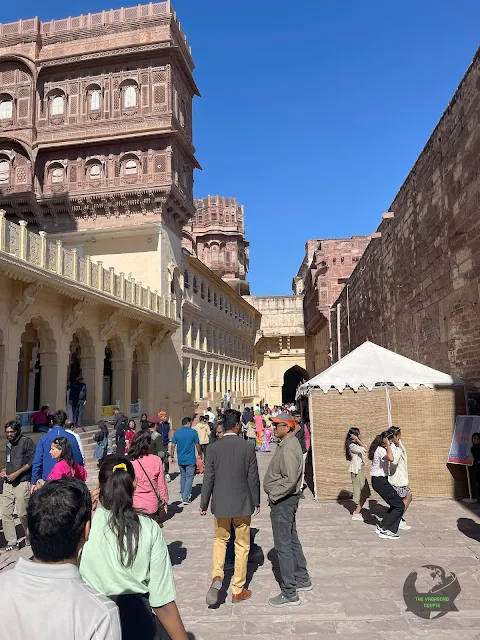 |
| Mehrangarh Fort |
Mehrangarh Fort stands as a testament to Rajput valor, architectural brilliance and enduring cultural heritage. More than just a historic monument, it is a vibrant space, buzzing with life and offering a glimpse into the soul of Rajasthan. Whether you're a history buff, an architecture enthusiast, or simply seeking an unforgettable experience, Mehrangarh Fort promises to leave you spellbound.
The Rajasthani Moustache
Among the numerous traditions in super-rich culture of Rajasthan, the Rajasthani moustache stands out more than just a fashion statement. It is a living tradition, a testament to the rich cultural tapestry of Rajasthan. Here is a gentleman we met sporting a quintessential Rajasthan moustache.
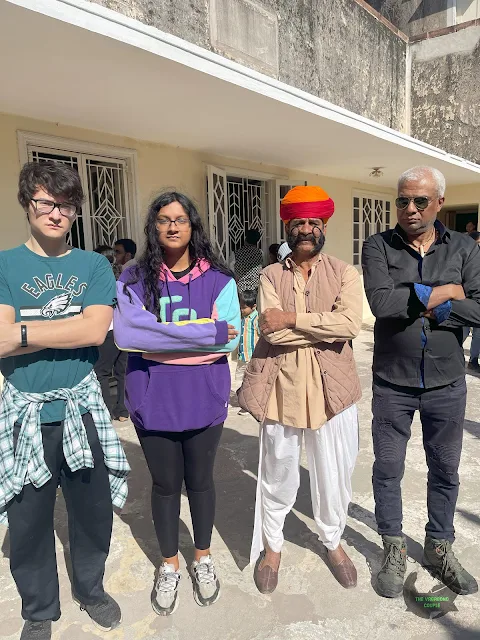 |
| Man with distinctive Rajasthan moustache |
So, the next time you encounter a man sporting an impressive Rajasthani moustache, take a moment to appreciate the story it tells, the history it embodies and the pride it reflects.
Jaswant Thada: A Marble Masterpiece
Jaswant Thada, a cenotaph commemorating Maharaja Jaswant Singh II, exudes an air of serene melancholy. Nestled amidst the rugged beauty of Jodhpur lies Jaswant Thada, a monument that whispers tales of Rajput royalty and architectural finesse.
 |
| Jaswant Thada |
Built in 1899 by Maharaja Sardar Singh as a tribute to his father, Maharaja Jaswant Singh II, Jaswant Thada transcends the boundaries of a mere cenotaph, transforming into a haven of serene artistry and historical significance.
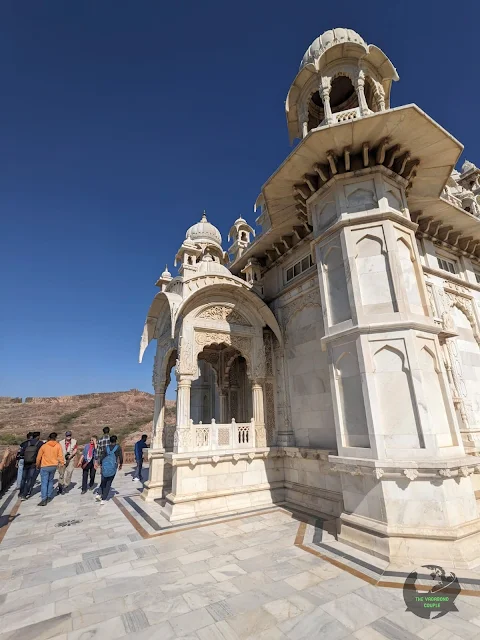 |
| Jaswant Thada |
Crafted from intricately carved sheets of Makrana marble (the same marble, from the town of Makrana, used in the Taj Mahal and the Victoria Memorial in Kolkata), Jaswant Thada exudes an ethereal aura.
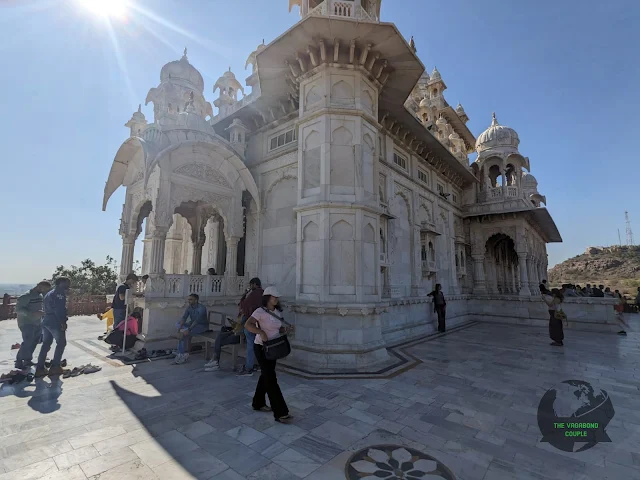 |
| Jaswant Thada |
The pristine white marble shimmers under the desert sun, casting delicate shadows that accentuate the intricate latticework and elaborate carvings adorning the structure.
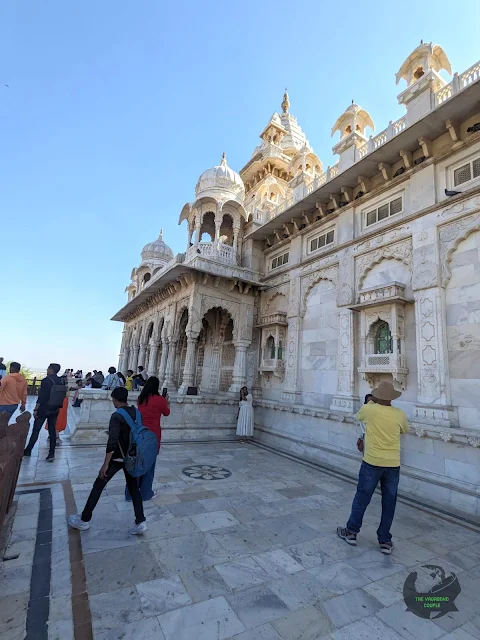 |
| Jaswant Thada |
As you approach the cenotaph, the main hall welcomes you with its temple-like ambiance. Ornate pillars and arches gracefully frame the cenotaphs of past rulers, their stories etched in stone. Portraits of Marwar rulers line the walls, offering a glimpse into their lineage and legacy.
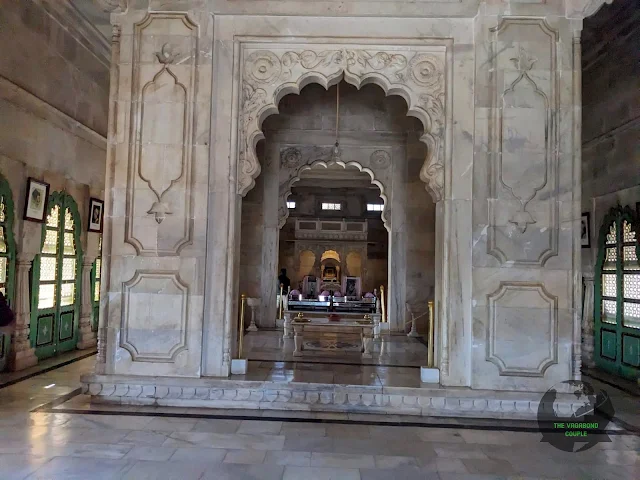 |
| Interior of Jaswant Thada |
Stepping beyond the confines of the main hall, you'll find yourself amidst picturesque gardens. Tiered levels adorned with carved gazebos and a lake create a tranquil oasis that invites you to linger and soak in the ambiance. The gentle gurgle of water and the chirping of birds add to the serene charm of the place.
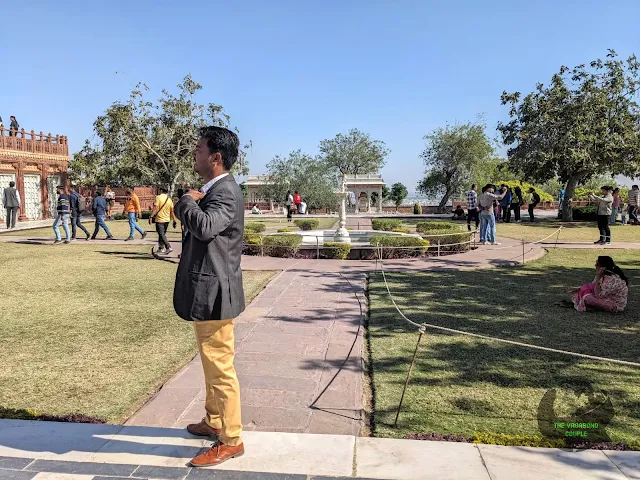 |
| Gardens of Jaswant Thada |
Jaswant Thada is also a cremation ground for royalty and nobility.
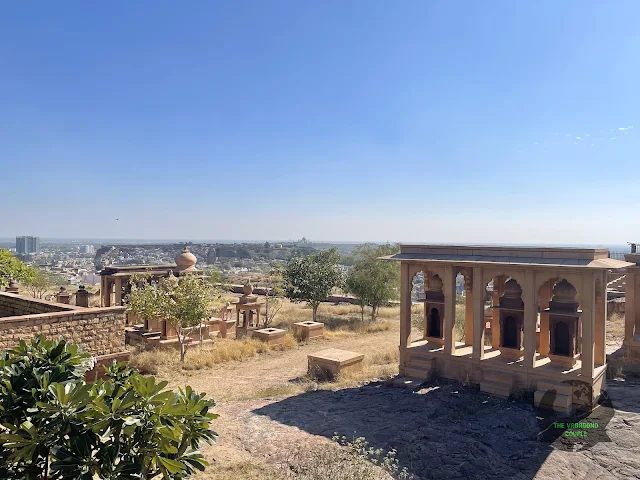 |
| Jaswant Thada royal crematorium |
The Umaid Bhawan Palace in Jodhpur can be seen in the distance from the Jaswant Thada.
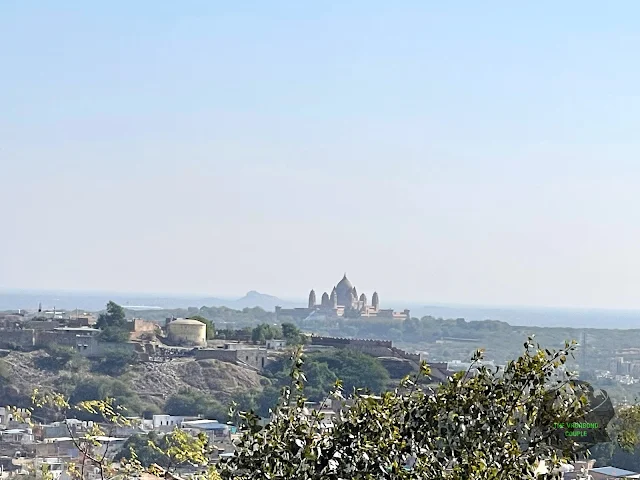 |
| Umaid Bhawan Palace seen from Jaswant Thada |
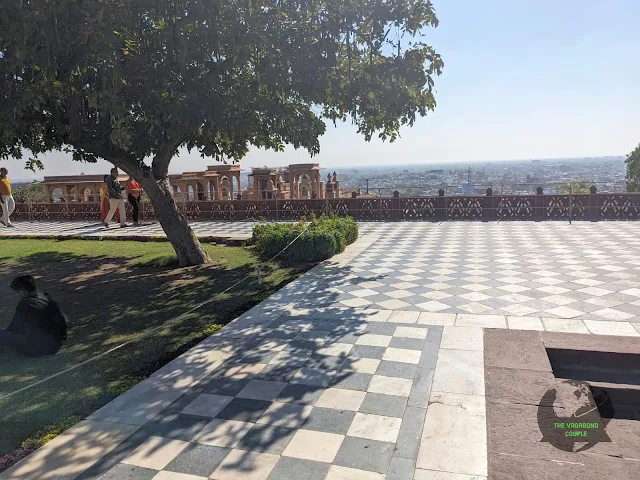 |
| View of Jodhpur from Jaswant Thada |
Jaswant Thada is more than just a memorial; it's a living testament to Rajput artistry and heritage. Today, it serves as a popular tourist destination, offering visitors a glimpse into the grandeur of a bygone era. The annual Mewar Festival sees the grounds of Jaswant Thada come alive with music and dance, further enriching the cultural tapestry of the monument.
Umaid Bhavan Palace
Umaid Bhavan Palace, a majestic yellow sandstone marvel perched atop Chittar Hill in Jodhpur, is much more than just a beautiful building. It's a testament to human ambition, a symbol of Rajput royalty and a luxurious haven for modern travelers.
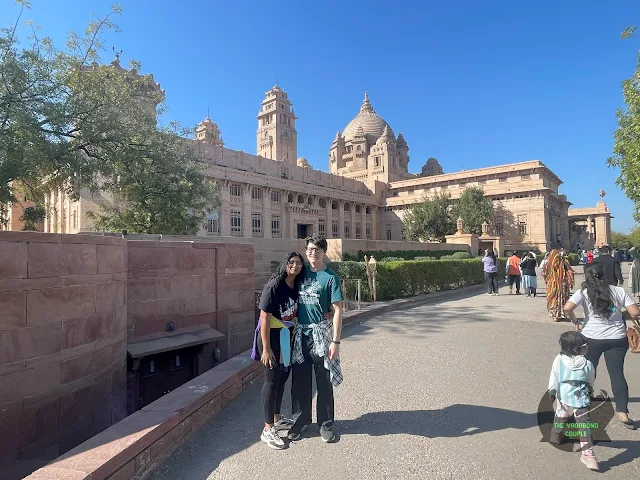 |
| Umaid Bhavan Palace |
Built relatively recently between 1928 and 1943 by Maharaja Umaid Singh II, the palace was a grand gesture of employment during a period of famine. With over 347 rooms, it's one of the world's largest private residences, combining elements of Art Deco, Renaissance and Rajput architectural styles. The exterior boasts intricate sandstone carvings, arched windows and towering cupolas, while the interiors dazzle with marble floors, gilded ceilings and exquisite chandeliers.
 |
| Umaid Bhavan Palace Museum |
Stepping inside Umaid Bhavan Palace is like stepping back in time. The Maharaja's private quarters, now part of a museum, showcase personal artifacts, royal portraits and lavishly decorated chambers. Wander through the Durbar Hall, where the Maharaja once held court and imagine the grandeur of past ceremonies.
 |
| Umaid Bhavan Palace Museum |
Today, a part of the palace operates as a luxurious Taj hotel, offering guests a chance to experience royal living. Stay in one of the 70 grand Art Deco-style rooms and suites, some with private balconies overlooking the sprawling gardens. Dine in opulent restaurants like Risala, featuring authentic Rajasthani cuisine, or Pillars, with its European and Mediterranean delicacies. Relax in the subterranean Zodiac Pool, play a game of tennis on one of the four courts, or unwind in the spa.
Umaid Bhavan Palace is surrounded by 26 acres of lush gardens, a haven for peacocks and offering stunning views of Jodhpur's "Blue City" and the Mehrangarh Fort. Take a guided tour to learn about the palace's history and architecture, or simply wander the grounds and soak in the serene atmosphere.
Jodhpur Old Town
The old town of Jodhpur is a charming and vibrant labyrinth of narrow streets, colorful houses and historic landmarks. It's a must-visit for any traveler to Jodhpur, offering a glimpse into the city's rich history and culture.
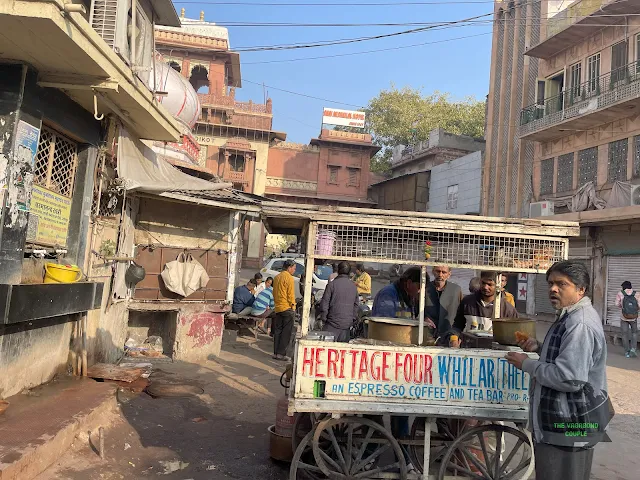 |
| Heritage Four Wheeler Espresso Coffee and Tea Bar, Jodhpur Old Town |
There is a 33-meter tall clock tower ("Ghanta Ghar Jodhpur") which is a popular landmark and offers great views of the old town. Sardar Market is a delightfully chaotic bustling bazaar that is a great place to shop for souvenirs, spices and textiles.
 |
| Sardar Market gate with the clock tower behind it |
For those like us looking for a more local experience, one can wander through the narrow streets, visit the local temples and mosques or enjoy a cup of chai at a traditional tea stall.
We drive to the outskirts of Jodhpur to the beautiful Kaylana Lake. Nestled just eight kilometers west of Jodhpur's azure embrace, Kaylana Lake shimmers like a jewel under the Thar Desert sun. This man-made marvel, birthed in 1872 by Maharaja Pratap Singh, sprawls over 84 square kilometers, its serene waters cradled by rugged igneous rock formations and vibrant Babool forests.
 |
| Kaylana Lake |
Beyond its life-giving role as Jodhpur's primary water source, Kaylana Lake pulsates with vibrant life. Migratory birds like Siberian cranes grace its shores in winter, their calls echoing across the still waters. For nature enthusiasts, trekking trails wind through the surrounding hills, offering breathtaking panoramas of the lake and its verdant environs. As dusk paints the sky in fiery hues, boat rides offer a front-row seat to the spectacle, the mirrored surface reflecting the city's twinkling lights like fallen stars. Kaylana Lake's tranquil beauty isn't just a feast for the eyes; it's a balm for the soul, a serene escape from the bustling city, whispering tales of Rajput legacy and whispering promises of an unforgettable desert sojourn.
As we leave Jodhpur for our next destination of a tent camp deep in the Thar desert near the city of Jaisalmer which is legendary for its golden fort, the blend of historical charm and modern vibrancy of captivating Jodhpur leaves an indelible mark on our minds. Here, sandstone isn't just a building material; it's a canvas, a living testament to the city's soul. The gentle play of light and shadow across its surface tells stories of the desert sun, the monsoon rains and the ever-watchful gaze of Mehrangarh.
Up next: Desert camping, Camel and ATV adventures at the dunes of Thar desert and the golden fort-city of India's only living fortress of Jaisalmer.
Note: Prose in this post received AI assistance from ChatGPT and Bard.

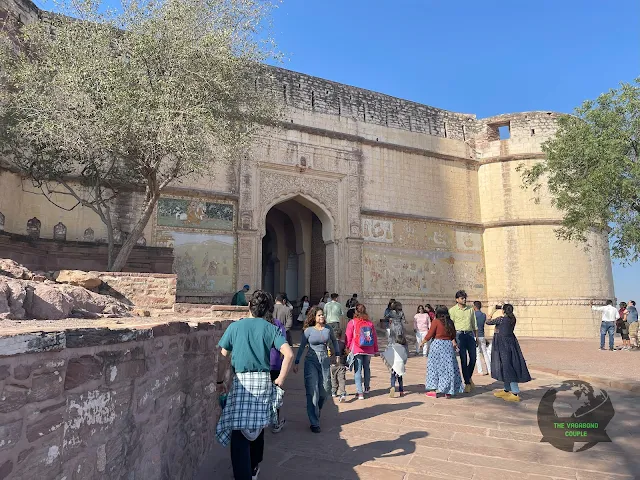





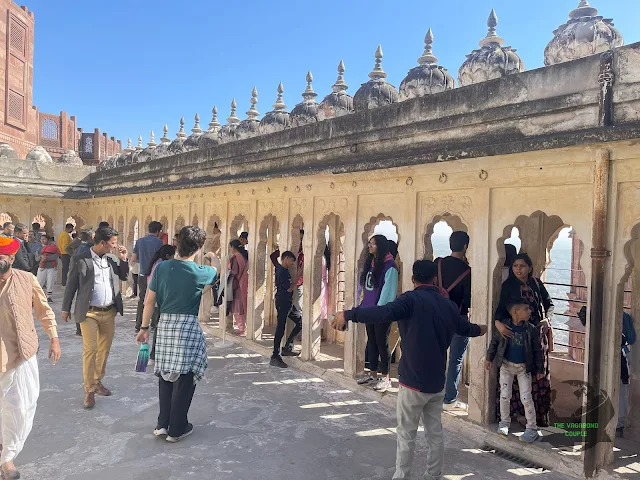
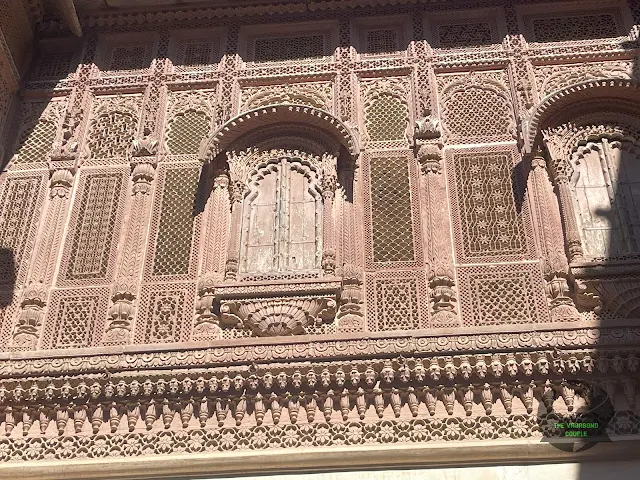

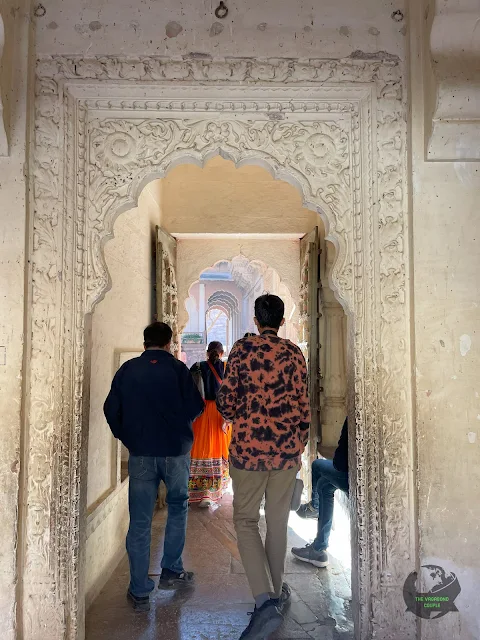

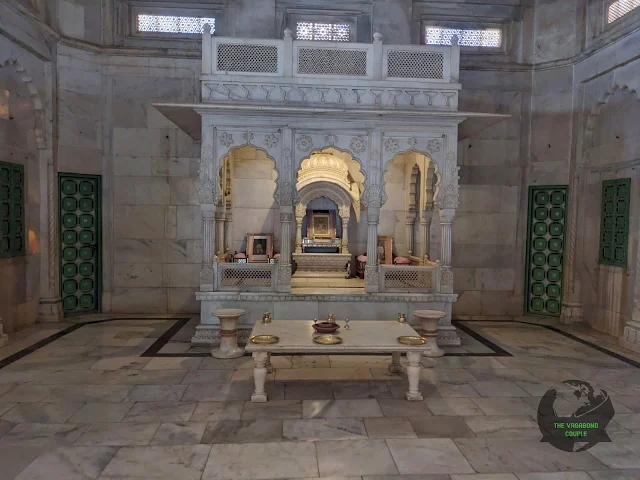
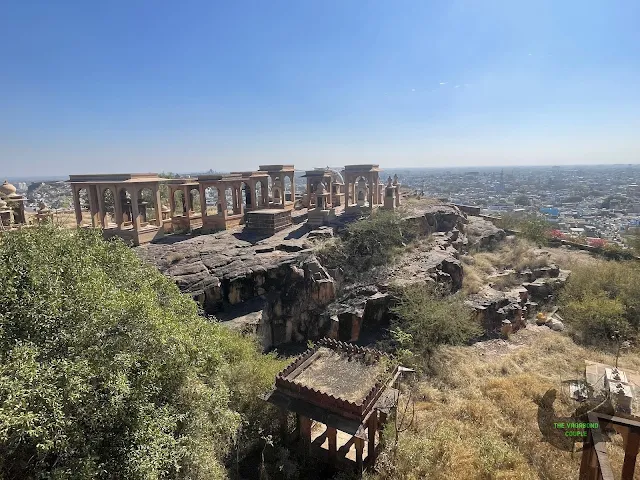

0 comments